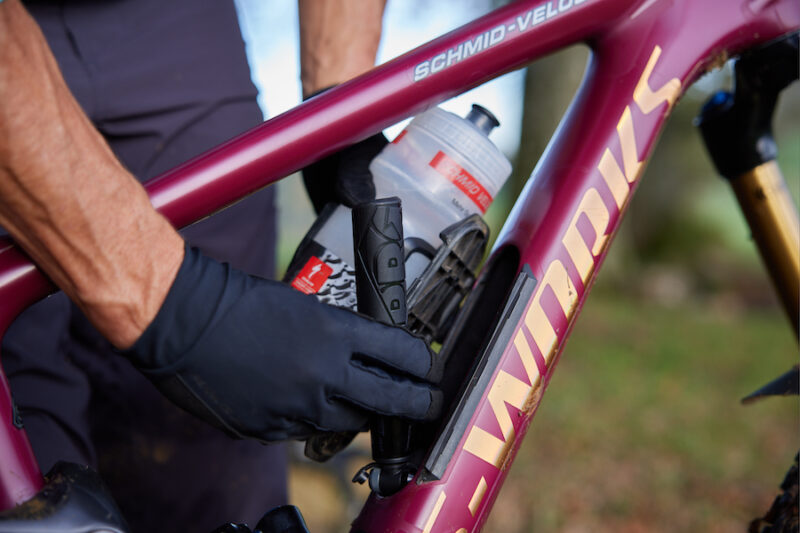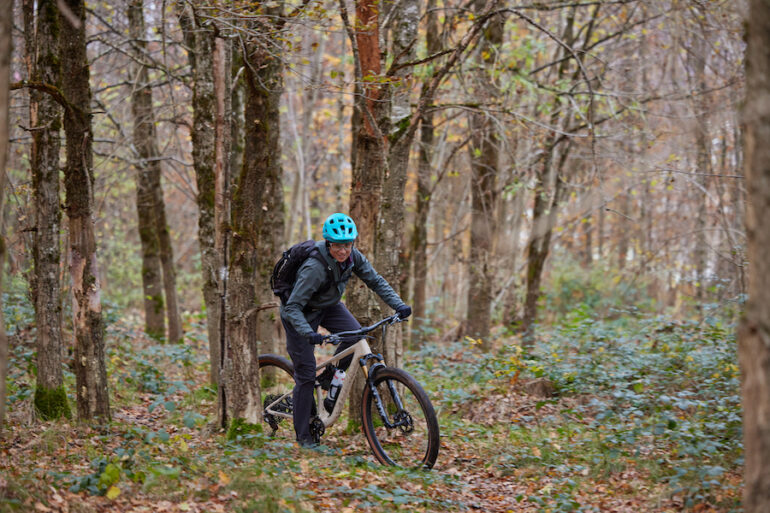Mountain biking, at its best, takes you into remote areas, even if these are sometimes just off the urban fringe; it’s easy to venture beyond the ell signal or out of reach of a taxi to carry you home if something breaks. It is, therefore, essential to not only carry the tools you need to fix the common issues bikes can develop on the trail but also know how to use them. PRO Community Rider, Monika Büchi, talks us through her setup and provides some hard-earned advice…
On rides into the backcountry, Monika Büchi brings the tools she needs to fix any mechanical failure. Fortunately for her, PRO makes carrying those tools easier than ever. Read on for inspiration on how you can #MakeItYours when it comes to trail-side repairs.
I have different ‘setups’ depending on what I’m going to do and which bike I’m riding. But there are some tools that I always carry with me, be they in the bike frame of my Specialized Enduro, in the PRO Smart Bottle Cage, or a hydration/hip bag. My general rule is that the further I ride from civilization, the more I’ll carry with me.
Bike Tubes
All my trail bikes have tubeless setups. To further reduce the risk of pink flats or catastrophic punctures, I even run an insert to protect the rim and allow me to safely ride it out if a tire ‘burps.’ Punctures do still happen, though. Sometimes the cut is too big to plug, and I always carry at least one spare tube for occasions like those.
When your tire’s sidewall is often badly cut, you’ll need to patch the inside of the wall to prevent the tube from protruding. A gel wrapper is perfect for this, as it is stiff enough not to be pushed through the hole by the pressure of the inflated tube but supple enough not to puncture the tube.
Due to space constraints, I’ve used the ultra-lightweight Tubolito tube. But from stashing it and leaving it for months, it rubbed inside the frame storage compartment of my Enduro and developed a hole. So, remember to check your spare tube regularly or store it so that it doesn’t rub up against anything that could puncture it.
Pumps and Cartridges

I find that carrying a pump is always useful. CO2 cartridges and adapters are great, but I prefer a pump because the canisters are single-use, and I prefer reusable products, like a pump, to reduce my environmental impact. My compact PRO Performance Minipump XS is small enough to fit in the frame storage of my Enduro, and it is also compatible with the PRO Smart Bottle Cage on my Epic Evo.
Despite not liking to use CO2 cartridges unnecessarily, I always carry at least one with me because you need the pressure they develop to reseat a tubeless tire if it comes off the rim. They are also quicker than pumps, so I use them in races. PRO offers separate CO2 adapters, like the Micro CO2 Inflator, or inflators built into mini tools, like the Team 20 Function CO2 mini tool
Carrying a pump also allows me to play with my tire pressure. Sometimes I’ll inflate my tires for a long tarmac climb and then deflate them again when hitting the trails. Playing with your tire pressure is also a good way to get a better feel for your bike. From doing this frequently, I can pretty much tell if my tire pressure is right by squeezing the sidewalls. Though recently, I changed to a different tire insert, which affected the whole feel of my bike. So, I’m back to checking my tire pressure with the PRO Pressure Checker Digital. Depending on where I’m riding and the conditions, I adjust my tire pressure; for example, I run lower pressures in the wet, and I run higher pressures in bike parks.
PRO Smart Bottle Cage

On my Specialized Epic Evo I don’t have a storage slot within the frame. To carry everything I need with me, I use the Smart Bottle Cage and PRO Storage Pouch. The Smart Bottle Cage allows me to carry a mini tool, like the Performance 13 Function Mini Tool which includes a chain breaker, or the Performance 9 Function Tubeless Mini Tool which has a tubeless puncture repair plug tool and reamer. The Smart Bottle Cage also has mounting points for two tire levers on one side, a pump or a CO2 cartridge, and an adaptor on the other. The Storage Pouch is the ideal location to house a spare tube.
For small cuts in your tire, a tubeless repair tool is vital. If your mini tool doesn’t have one built a small separate repair tool, like the Dynaplug, will do the trick.

Just remember, when flying with your bike, CO2 cartridges are not allowed on planes at all. I had to return to the terminal to take one out of my bike bag, which had already been checked in. The security x-ray found it before the baggage handlers started loading the plane. A friend found his bike bag cut upon reaching the destination, which is far worse. The baggage handlers cut the bag to pull the cartridge out.
Mini Tools

You always need a small tool to loosen or tighten bolts, remove the Thu-axel to take the wheel out, and ensure every bolt is tight after a trip. Plus, you may need to readjust the brake levers or straighten your handlebar after a crash. Make sure your mini tool has all the screwdriver bit, hex keys, and Torx keys your bike requires. You never know when you’ll need to remove your brake pads, with a slotted screwdriver, for example.
On shorter rides, I rely on the very compact tool I store in my steerer. But on longer adventures, I carry the PRO Mini Tool 22 Functions because it is remarkably comprehensive. Not only does it feature a tire lever and chain tool, but it has also a Phillips head screwdriver, seven hex keys, two Torx keys, four spoke wrenches, and four traditional wrenches.
Learning how to fix a broken chain is one of the most important mechanical skills you should master. Often removing one link from a chain, or inserting a quick spare link, won’t affect your shifting too much. But if you break your derailleur or hanger, you’ll need to convert your bike to a single speed to limp back to civilization. Full suspension bikes are difficult to convert to single speeds due to the chain growth created by suspension travel. So, lock your suspension out, and you have a suspension pump handy; pump it as hard as possible.
Riding Extras
On longer rides, I pack a hip or hydration pack with extras I might need, including a PRO Performance Suspension Pump, brake pads, a shift cable, and a spare derailleur hanger for the bike I’m riding on that trip. A small pair of pliers can also be very useful. But the most important additional items I carry are a small bottle of chain lube, zip ties, duct tape, and spare tubeless puncture repair plugs. These four items are relatively small and light and can fit in a jersey pocket or a section of my hydration pack.
As you might have gathered, I prefer to ride with a pack to carry the tools I may need, my nutrition, enough fluid for a long ride, and a small first aid kit. My first aid kit also has a space blanked and a fire starter, just in case I get caught out overnight because of an injury.
When riding with friends, I also try to ensure we aren’t doubling up. And divide the group’s heavier and less frequently needed tools or spares.
Trips Abroad

I like to pack the spares for longer trips, especially to races abroad, allowing me to fix my bike should anything break between rides/races. I take spare spokes, a replacement derailleur, and a spare brake disc, chain, and brake pads. New tires, rim tape, or a spare wheel are also great things to travel with and can save you from missing multiple days of riding or racing.

